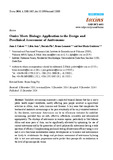Buscar
Mostrando ítems 1-10 de 48
Venomic and antivenomic analyses of the Central American coral snake, Micrurus nigrocinctus (Elapidae)
(2011-01-31)
The proteome of the venom of Micrurus nigrocinctus (Central American coral snake) was analyzed by a “venomics” approach. Nearly 50 venom peaks were resolved by RP-HPLC, revealing a complex protein composition. Comparative ...
Venomics of the poorly studied hognosed pitvipers Porthidium arcosae and Porthidium volcanicum
(2021)
We report the first proteomics analyses of the venoms of two poorly studied snakes, the Manabi hognosed pitviper Porthidium arcosae endemic to the western coastal province of Manabí (Ecuador), and the Costa Rican hognosed ...
What’s in a mass
(2021-04)
This short essay pretends to make the reader reflect on the concept of biological mass and on the added value that the determination of this molecular property of a protein brings to the interpretation of evolutionary and ...
Snake Venomics of the Lesser Antillean Pit Vipers Bothrops caribbaeus and Bothrops lanceolatus: Correlation with Toxicological Activities and Immunoreactivity of a Heterologous Antivenom
(2008-10)
The venom proteomes of the snakes Bothrops caribbaeus and Bothrops lanceolatus, endemic to the
Lesser Antillean islands of Saint Lucia and Martinique, respectively, were characterized by reversephase
HPLC fractionation, ...
Venomics of the Duvernoy's gland secretion of the false coral snake Rhinobothryum bovallii (Andersson, 1916) and assessment of venom lethality towards synapsid and diapsid animal models
(2020)
The Duvernoy's gland secretory proteome of the false coral snake Rhinobothryum bovallii (Costa Rica), unveiled applying bottom-up venomics, comprises a handful of toxins belonging to only three protein families, three-finger ...
Combined venom gland cDNA sequencing and venomics of the New Guinea small-eyed snake, Micropechis ikaheka
(2014-10-14)
The venom arsenal of the New Guinea small-eyed snake, Micropechis ikaheka, was investigated by a joint cDNA sequencing and venomics approach. Twenty-seven full-length DNA sequences encoding novel venom proteins were recovered ...
Omics Meets Biology: Application to the Design and Preclinical Assessment of Antivenoms
(Toxins vol.6:3388-3405, 2014-12-15)
Snakebite envenoming represents a neglected tropical disease that has a heavy public health impact worldwide, mostly affecting poor people involved in agricultural activities in Africa, Asia, Latin America and Oceania. A ...
Preclinical evaluation of the efficacy of antivenoms for snakebite envenoming: State-of-the-art and challenges ahead
(2017-05)
Animal-derived antivenoms constitute the mainstay in the therapy of snakebite envenoming. The efficacy of antivenoms to neutralize toxicity of medically-relevant snake venoms has to be demonstrated through meticulous ...
Venomics and antivenomics of Bothrops erythromelas from five geographic populations within the Caatinga ecoregion of northeastern Brazil
(2015-01-30)
The Caatinga lancehead, Bothrops erythromelas, is a medically relevant species, responsible for most of the snakebite accidents in most parts of its distribution range in northeastern Brazil. The spectrum and geographic ...
Snake venomics of the South and Central American Bushmasters. Comparison of the toxin composition of Lachesis muta gathered from proteomic versus transcriptomic analysis
(2008-04-30)
We report the proteomic characterization of the venoms of two closely related pit vipers of the genus Lachesis, L. muta (South American Bushmaster) and L. stenophrys (Central American Bushmaster), and compare the toxin ...





